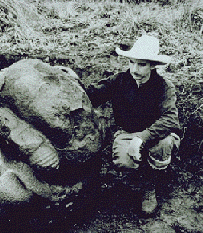Matthew Williams Stirling
 Matthew Stirling's career in anthropology and archaeology was spent almost entirely at the Smithsonian Institution. Geographically, it spanned from New Guinea to the Americas, and his contributions to scholarship were equally as broad. Educated at the University of California at Berkeley and The George Washington University, he was both an active field worker and an able administrator serving as Chief of the Smithsonian Institution's Bureau of American Ethnology (BAE) for almost 30 years (1928-1957). During that time, he managed to actively publish as well, an unusual feat for many administrators. In 1933 he married Marion Illig, and together they shared an exciting and productive career in both the field and in co-authoring a number of scientific publications.
Matthew Stirling's career in anthropology and archaeology was spent almost entirely at the Smithsonian Institution. Geographically, it spanned from New Guinea to the Americas, and his contributions to scholarship were equally as broad. Educated at the University of California at Berkeley and The George Washington University, he was both an active field worker and an able administrator serving as Chief of the Smithsonian Institution's Bureau of American Ethnology (BAE) for almost 30 years (1928-1957). During that time, he managed to actively publish as well, an unusual feat for many administrators. In 1933 he married Marion Illig, and together they shared an exciting and productive career in both the field and in co-authoring a number of scientific publications.
Stirling's contact with Latin America first came in the mid 1920s when he explored the upper Amazon in Campa Indian territory, acquiring a large textile collection. He returned to Ecuador as a member of the Donald C. Beatty Latin American Expedition in the early 1930s. His attention then turned to Mexico and Central America where between 1938 and 1946 he carried out archaeological excavations at such important sites as Tres Zapotes, Cerro de las Mesas, La Venta, Izapa, and San Lorenzo. During this time he explored the virtually unknown Olmec culture and dated it as the precursor of other Mesoamerican cultures, including the Mayan. Finally, from 1948 to 1954, he turned his attention to searching for links between Mesoamerican cultures and those of South America in such countries as Panama, Ecuador, and Costa Rica. In addition to this considerable fieldwork, Stirling was also the chief organizer of the seven-volume Handbook of South American Indians edited by Julian Steward and including the works of 96 specialists as well as the BAE's Institute of Social Anthropology, an autonomous unit to promote cooperation in anthropological training and research throughout the Americas. Matthew Stirling's achievements were substantial and his contributions to Latin American scholarship remain crucial to the continued growth of that discipline today.
Related Collections
- An archeological reconnaissance in Southeastern Mexico, by Matthew Williams Stirling, 1957, Smithsonian Libraries
- El Limón, an early tomb site in Cocle; Province, Panama, By Mathew and Marion Stirling,1964, Smithsonian Libraries
- Uncovering Mexico's Forgotten Treasures, edited film shot for a National Geographic Society and Smithsonian Institution expedition to Mexico led by Matthew Stirling, 1940, Human Studies Film Archives, Smithsonian Museum Support Center
